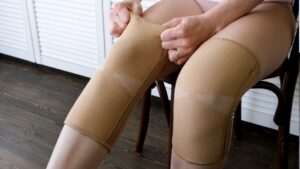Choosing Compression Garments is essential for many reasons. A compression sleeve or waist will likely only cover the areas that need it most, if at all, and conceal other parts which you may not want to share in public.
If you’re not sure how to measure the correct size of type of garment, it’s best to consult your healthcare provider. They will also help determine which type is best for you and why.
What are compression garments?
Compression garments are used for several different body parts but mainly apply to the legs, arms, abdomen, and chest. These garments can treat various ailments, such as edema, lymphedema, or DVT, amongst other conditions. Compression stockings or sleeves will also reduce the muscle soreness a person will get from working out or sitting at a computer for extended periods.
How many types of compression garments exist?
When it comes to compression garments, there are four types: elastic bandages, pressure & compression stockings, lifting gloves, and sleeves. Elastic bandages are designed for minor injuries or swelling, such as ankle strains or post-operation on the legs. These garments cannot be tightly wrapped but can still be effective if applied correctly.
Choosing Compression Garments
 Elastic bandages
Elastic bandages
They come in several different sizes and are designed to be wrapped around the affected area, tightening when worn over a long period. Elastic bandages can be worn for up to 24 hours straight.
Use: For minor injuries or swelling, such as ankle strains.
- Principle of operation: Embrace the swelling and gently squeeze to restrict blood flow out of the area.
- Advantages: Lightweight, easy to apply and remove, mild discomfort.
- Disadvantages: Can’t be rolled up tight enough to be effective, not as effective if there is a lot of swelling.
Pressure & Compression Stockings
They work similarly to elastic bandages but are made of fabric to avoid irritation and are generally more accessible for people to apply correctly. Pressure & compression stockings can be worn for up to 24 hours straight and will not get stretched out like elastic bandages if you wear them too tightly.
- Use: For minor injuries or swelling, such as ankle strains.
- Advantages: More effective than elastic bandages when swelling is considerable, can be rolled up tight enough to restrict blood flow out of the affected area, and thus be very effective if necessary.
- Disadvantages: It can cause blisters and isn’t as quick and easy to apply as elastic bandages are.
Lifting Gloves
Similar to pressure & compression stockings, but have a few extra features. The gloves are designed with a little more fabric and have an inbuilt pad to stabilize blood flow and restrict painful movements from an area that’s been injured. At the other end, a Velcro strap usually tightens firmly around an area for further compression. Lifting gloves can be worn for up to 24 hours straight and are more accessible for people to apply correctly than pressure & compression stockings.
Use: For minor injuries such as ankle strains.
- Principle of operation: Pulls the affected area towards the heart, restricting blood flow and making it easier for the body to build new tissue and reduce swelling.
- Advantages: Can be rolled up tight enough to restrict blood flow out of the affected area, easy to apply and remove, and can stabilize weak or sprained areas for smoother healing.
- Disadvantages: It can cause blisters.
Sleeves
Sleeves are designed to be worn on the arms or chest. They are often used to tighten loose skin after weight loss but can also be effective in reducing edema from other causes.
Use: To tighten loose skin after weight loss and reduce edema from other causes.
- Principle of operation: Pulling the affected area towards the heart, restricting blood flow and making it easier for the body to build new tissue and reduce swelling.
- Advantages: It can be rolled up tight enough to restrict blood flow out of the affected area and reduce swelling for smoother healing.
- Disadvantages: It can cause blisters and irritation.
Benefits of Compression Garments
Decreased muscle soreness
Muscle soreness and improved recovery time are often the results of working out. Compression garments can help to prevent this.
Increased blood volume
Many athletes use compression garments to help them achieve their best performance, and with good reason. More blood in your muscles means they will have more oxygen, allowing quicker recovery and minor soreness afterward.
Decreased muscle vibration
It is a result of increased blood flow and lower muscle vibration. If you suffer from recurring muscle injuries or arthritis, you may find that the garments alleviate your symptoms.
Decreased swelling
Compression garments can be used to treat several different ailments, including edema and lymphedema. They can also reduce the swelling that occurs after an injury, such as a sprained ankle or foot.
Faster healing
Many people fast from physical activity for religious or cultural reasons and therefore find it difficult to return to everyday life with all of their standard functionality intact. In some cases, such as post-operative recovery, compression garments can make it possible for people to return to their activities sooner than before by reducing swelling in the affected area.
Reduced pain
Compression garments can be used to reduce pain and help someone manage their discomfort for a variety of ailments.
Better sleep
Sleeves have been shown to improve sleep quality for those who wear them, allowing for deeper, more restful sleep. Researchers aren’t sure why this is, but it may be because compression garments increase blood flow to the muscles and organs, ensuring that they get the nutrients they need while sleeping.
Tips on Choosing Compression Garments
Here are a few tips to help you choose the best compression garment for your needs.
Sleeve style
Compression sleeves come in three main styles: straight seam, wrap-style and bound-style. The latter is the most common style in modern times. These sleeves are made from a single piece of fabric, which has been sewn together at the shoulder to create an opening for the arm that can then be closed with a Velcro strap or button closure at the wrist.
Sleeve material
These garments are made from Lycra, a synthetic fabric known as spandex. Lycra is stretchy and breathable, allowing the garment to hug the body while providing compression. It’s also comfortable to wear. This fabric can be smooth or have a sheen, which will make it easier to wash and keep clean.
Stretch factor
Compression garments are often labeled as low-stretch or premium-stretch.
Length
Compression sleeves can be worn over the entire arm, from shoulder to wrist, or they can be worn from the shoulder to just above the elbow.
Circumference
The circumference is the measurement around your arm at a specific point. It should be measured around your biceps, where you would wear the garment, and not necessarily around the broadest part of your arm if that’s larger than the bicep. The standard measurement that manufacturers use is between 18 and 28 inches.
The applications of compression garments are diverse, but they also have their limits. When you invest in these garments, you should be aware that they’re most effective for reducing swelling and pain caused by repetitive stress injuries like tendonitis or carpal tunnel syndrome and for situations in which edema is caused by a specific injury such as a broken ankle or torn knee ligament. They can also be used to improve circulation and clear the lymphatic system of excess fluids and toxins by applying negative pressure.
For inquiries, please email our office at [email protected], and we will send a quick reply will be sent about your condition. If you require a personal consultation that requires an appointment, please call the office today at 416-782-5353.


